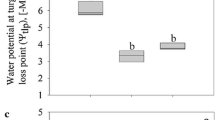Abstract
Earlier experiments (T.D. Brock 1975, Planta124, 13–23) addressed the question whether the fungus of the lichen thallus might enable the algal component to function when moisture stress is such that the algal component would be unable to function under free-living conditions. It was concluded that the liberated phycobiont in ground lichen thalli could not photosynthesize at water potentials as low as those at which the same alga could when it was present within the thallus. However, our experience with lichen photosynthesis has not substantiated this finding. Using instrumentation developed since the mid-1970's to measure photosynthesis and control humidity, we repeated Brock's experiments. When applying “matric” water stress (equilibrium with air of constant relative humidity) we were unable to confirm the earlier results for three lichen species including one of the species,Letharia vulpina, had also been used by Brock. We found no difference between the effects of low water potential on intact lichens and their liberated algal components (ground thallus material and isolated algae) and no indication that the fungal component of the lichen symbiosis protects the phycobiont from the adverse effects of desiccation once equilibrium conditions are reached. The photosynthetic apparatus of the phycobiont alone proved to be highly adapted to water stress as it possesses not only the capability of functioning under extremely low degrees of hydration but also of becoming reactivated solely by water vapor uptake.
Similar content being viewed by others
Abbreviations
- PAR:
-
photosynthetically active radiation
References
Arnon, D.I. (1949) Copper enzymes in isolated chloroplasts. Polyphenoloxidase inBeta vulgaris. Plant Physiol.24, 1–15
Ascaso C. (1980) A rapid method for the quantitative isolation of green algae from lichens. Ann. Bot.45, 483
Bertsch, A. (1966) CO2-Gaswechsel und Wasserhaushalt der aerophilen GrünalgeApatococcus lobatus. Planta72, 46–72
Bilger, W., Rimke, S., Schreiber, U., Lange, O.L. (1989) Inhibition of energy-transfer to photosystem II in lichens by dehydration: different properties of reversibility with green and blue-green phycobionts. J. Plant Physiol.134, 261–268
Brock, T.D. (1975) The effect of water potential on photosynthesis in whole lichens and in their liberated algal components. Planta124, 13–23
Butin, H. (1954) Physiologisch-ökologische Untersuchungen über den Wasserhaushalt und die Photosynthese bei Flechten. Biol. Zentralbl.73, 459–502
Evans, A.W. (1943) Microchemical studies on the genusCladonia, subgenusCladina. Rhodora45, 417–438
Kappen, L. (1988) Ecophysiological relationships in different climatic regions. In: Handbook of Lichenology II; pp. 37–100, Galun, M., ed, CRC Press, Boca Raton, Fla., USA
Kershaw, K.A. (1985) Physiological ecology of lichens. Cambridge University Press, London New York
Lange, O.L., Kilian, E. (1985) Reaktivierung der Photosynthese trockener Flechten durch Wasserdampfaufnahme aus dem Luftraum: Artspezifisch unterschiedliches Verhalten. Flora (Jena)176, 7–23
Lange, O.L., Redon, J. (1983) Epiphytische Flechten im Bereich einer chilenischen „Nebeloase” (Fray Jorge). II. Ökophysiologische Charakterisierung von CO2-Gaswechsel und Wasserhaushalt. Flora (Jena)174, 245–284
Lange, O.L., Tenhunen, J.D. (1981) Moisture content and CO2 exchange of lichens. II. Depression of net photosynthesis inRamalina maciformis at high water content is caused by increased thallus carbon dioxide diffusion resistance. Oecologia (Berlin)51, 426–429
Lange, O.L., Tenhunen, J.D. (1982) Water relations and photosynthesis of desert lichens. J. Hattori Bot. Lab.53, 309–313
Lange, O.L., Kilian, E., Ziegler, H. (1986) Water vapor uptake and photosynthesis of lichens: performance differences in species with green and blue-green algae as phycobionts. Oecologia (Berlin)71, 104–110
Lange, O.L., Bilger, W., Rimke, S., Schreiber, U. (1989) Chlorophyll fluorescence of lichens containing green and blue-green algae during hydration by water vapor uptake and by addition of liquid water. Bot. Acta102, 306–313
Millbank, J.W., Kershaw, K.A. (1969) Nitrogen metabolism in lichens. I. Nitrogen fixation in the cephalodia ofPeltigera aphthosa. New Phytol.68, 721–729
Nash III, T.H., Reiner, A., Demmig-Adams, B., Kilian, E., Kaiser, W.M., Lange, O.L. (1990) The effect of atmospheric desiccation and osmotic water stress on photosynthesis and dark respiration of lichens. New Phytol., in press
Ronen, R., Galun, M. (1984) Pigment extraction from lichens with dimethyl sulfoxide (DMSO) and estimation of chlorophyll degradation. Environ. Exp. Bot.24, 239–245
Author information
Authors and Affiliations
Rights and permissions
About this article
Cite this article
Lange, O.L., Pfanz, H., Kilian, E. et al. Effect of low water potential on photosynthesis in intact lichens and their liberated algal components. Planta 182, 467–472 (1990). https://doi.org/10.1007/BF02411401
Received:
Accepted:
Issue Date:
DOI: https://doi.org/10.1007/BF02411401




